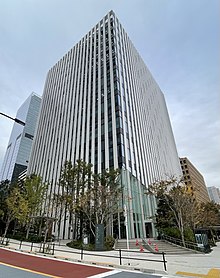This article has multiple issues. Please help improve it or discuss these issues on the talk page. (Learn how and when to remove these messages)
|
| Kishō-chō (気象庁) | |
 Logo | |
 Headquarters building in Tokyo | |
| Agency overview | |
|---|---|
| Formed | July 1, 1956 |
| Preceding agencies |
|
| Jurisdiction | Government of Japan |
| Headquarters | 3-6-9 Toranomon, Minato City, Tokyo, Japan 35°39′57″N 139°44′45″E / 35.66583°N 139.74583°E |
| Employees | 5,539 (2010)[1] |
| Annual budget | ¥62.0 billion (2010–11)[2] ¥59.0 billion (2011–12)[3] ¥58.9 billion (est. 2012)[3] |
| Agency executives |
|
| Parent agency | Ministry of Land, Infrastructure, Transport and Tourism |
| Website | jma.go.jp |
The Japan Meteorological Agency (気象庁, Kishō-chō), a division of the Ministry of Land, Infrastructure, Transport and Tourism, is dedicated to the scientific observation and research of natural phenomena. Headquartered in Minato, Tokyo the agency collects data on meteorology, hydrology, seismology, and volcanology, and other related fields. Through analysis and interpretation of this information, the JMA provides insights to the public, offering knowledge and forecasts to enhance preparedness and mitigate risks associated with weather patterns, earthquakes, volcanic activities, and other natural occurrences.
The Japan Meteorological Agency (JMA) is responsible for collecting and disseminating weather data and forecasts to the public, as well as providing specialized information for aviation and marine sectors. Additionally, the JMA issues warnings for volcanic eruptions and is integral to the nationwide Earthquake Early Warning (EEW) system. As one of the Regional Specialized Meteorological Centers designated by the World Meteorological Organization (WMO), the JMA also forecasts, names, and distributes warnings for tropical cyclones in the Northwestern Pacific region. This includes areas such as the Celebes Sea, the Sulu Sea, the South China Sea, the East China Sea, the Yellow Sea, the Sea of Japan and the Sea of Okhotsk.
- ^ 総合パンフレット「気象庁」 (PDF) (in Japanese). Japan Meteorological Agency. January 2011. Archived from the original (PDF) on March 31, 2012. Retrieved April 1, 2012.
- ^ 平成23年度 気象庁関係予算決定概要 (PDF) (in Japanese). Japan Meteorological Agency. December 24, 2010. Retrieved April 1, 2012.
- ^ a b 平成24年度 気象庁関係予算決定概要 (PDF) (in Japanese). Japan Meteorological Agency. December 24, 2011. Retrieved April 1, 2012.